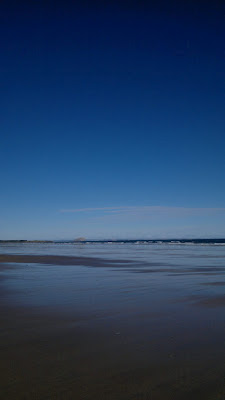At 6 am the mist rises off the loch into a cool blue
pre-dawn. By 7am the hills are pinkish brown and invitingly autumnal, painted
by rosy-fingered dawn*.
Oh Scotland: you rain
and you rain and then you stop and then I fall in love with you some more.
The train ran away from the mountains though, to the south
and east, to the coast of Lothian. It rides past the burns and rivers of the
central belt, a landscape unsurprisingly, but unfairly ignored. From a viaduct
you can look down upon the mist rising, turned golden by the sun. Up above is a
saltire sky.
Sudden scarcity will
do that to you. You don’t miss the everyday things until they’re gone. It’s a
cliché but it really does rain everyday here: coming from one of the driest
parts of England, September is a meteorological culture shock. It’s enough to
turn you pagan and to worshipping the sun when it eventually appears.
I disembark at Dunbar. The hometown, oddly, of America’s
first conservationist, John Muir. In this small corner of south east Scotland
he has a wedge of land dedicated to him. A thin triangle of saltmarsh and dunes
separates the waves breaking in Tyninghame Bay from breaking the roads of Dunbar and
Belhaven. It has to be said, it’s not exactly El Capitan, Yosemite or any of
the other American exceptional wilderness Muir helped preserve, but 21st
southern Scotland is a different proposition from 19th century
western America. Something now is much better than nothing. Even if the
something is just a handy area for dog walkers to get a lap in.
The view though. Wet
brown sand like a stained mirror: a paler blue reflection of the sky streaked
with brown and stretching across the bay. White-capped waves seem to take the
approach leisurely as if reserving their venom for the unsheltered side of
Dunbar. Just the faintest cloud hovers on the skyline over Fife. Bass Rock
disrupts the smoothness of the scene like a lumpy tooth thrust out of a gum.
Still speckled white with Gannets. Unlike a tooth, that bit.
Several Guillemots float just off shore. Gannets were going
haywire in the Firth; large numbers of adults, juveniles and immatures moving
in every direction. They survived or missed the wreck. The Guillemot amongst
the flotsam in the tideline was less lucky: a dogwalker leant over to inspect
its penguin like corpse.
Twitching is lazy but
it’s also an opportunity; one from time to time I see no reason not to take.
The other Suffolk to Stirling culture shock is the birds. Or rather Stirling’s
lack of them. Back home I can see all the waders you’d expect: my wader list
for Stirling is… non-existent pretty much. Buff-breasted Sandpipers are heaven
sent waders. Ruff are nice, but gangly and not particularly exciting. The
Buff-breasts are American, nest-fresh juveniles that got lost somewhere over
Nova Scotia and ended up old Scotland. But they’ve got such long wings you can
forgive these juveniles for getting lost on their first proper use of them.
Over the dunes I get my first peek at what I came for. An artist slumped over a sketchbook on the edge of the dunes was rather helpful:
several feet away a pair of Buff-breasted Sandpipers ran over the saltmarsh, up
to their legs in the marsh. Not wishing to break the skyline I crawled closer
to the artist, using him as cover. I needn’t have bothered. These sandpipers
were unusual: instead of flying at signs of danger, like the Starlings sharing
the marsh did when a Sparrowhawk cruised lazily overhead, they merely crouched
up to their heads in the vegetation.
At distance, birds
remain impersonal. Up close you get something of their character. When you make
mutual eye-contact, and the bird remains unconcerned, you can discern the
elements that don’t make it into the fieldguide. There is no more special
moment in birding than this. It’s hard not to anthropomorphise, but dry
scientific objectivism can’t explain the quirks, the look and feel of a bird
that lies beyond how it looks, how it walks. A Ruff would never crouch, it
would fly. That a Buff-breasted Sandpiper crouches is endearingly different.
You like them more because of it.
There’s worth in recording the arrival of a bird, and when
it leaves, especially if it’s unusual. But twitching as part of a crowd is a
purely selfish activity. I’m aware that this is using birds as prozac, birds as
therapy. But birds make me happy, happier than slogging through the Latinate
poetry of John Milton, so why shouldn’t I?
You see things that
way. Places, animals, people you wouldn’t otherwise. So really, why not?
‘The mind is its own place, and in itself / Can make a
heaven of hell, a hell of heaven’ (PL, Book I, L.254-255).
*If you think that’s pretentious you probably don’t realise
I stole it from Homer’s Odyssey. I stole it because it’s accurate and he’s too
dead to sue me.



No comments:
Post a Comment